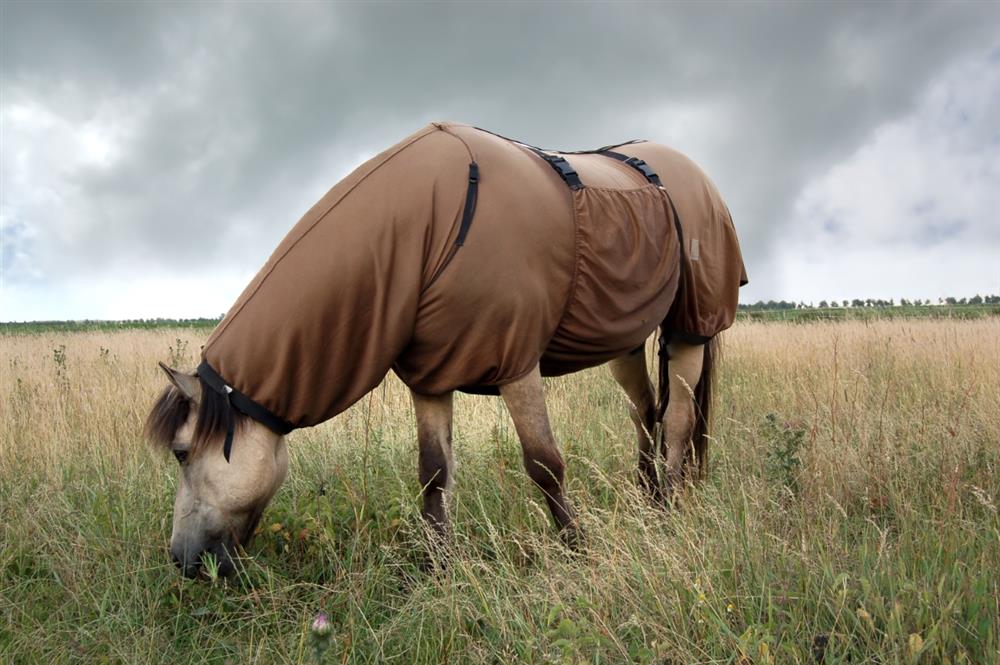The change of seasons, particularly from winter to spring can prove a challenging time for your horse’s skin. Whether it’s the process of shedding the winter coat that is causing your horse to itch and rub, or your horse is sadly affected by a skin condition, it can be a challenge to maintain your horse’s healthy skin.
Good skin health is so important for your horse as the skin has several vital roles, including acting as a barrier to external challenges, helping to control body temperature and also helping to make vitamin D. Generally, if the horse has a suitable diet providing adequate vitamins and minerals, skin health is rarely an issue. However, there are many horses that suffer with skin conditions such as rain scald, mud fever affecting the lower limbs, dermatitis or lice. one of the most common is ‘sweet itch’, also known as equine insect bite hypersensitivity.

What is sweet itch?
Sweet itch is a skin allergy caused by a reaction to saliva of the Culicoides midge; a small flying insect. Horses with this condition typically suffer with severe itching from about April to September when midges are active. The irritation can cause the horse to rub and scratch the affected areas intensely, which can lead to patchy hair loss, sores and scabs.
Hypersensitivity to the midge can be categorized into two allergies posing different reactions. Some horses may react immediately and often present in hives, whereas others (more commonly) have a delayed reaction causing itching to particular areas of the body and some horses may have symptoms of both.
The vet will diagnose the condition following an examination including dermatologic testing. A cure hasn’t yet been found, despite on going research, but treatment may include topical corticosteroids and systemic antihistamines.
An informative article on sweet itch can be found here.
Tips for managing sweet itch
- If you know your horse has previously suffered with sweet itch, it is important to start taking precautions early in the season.
- Avoid turning out between dawn and dusk when midges are most active.
- If possible, turn your horses out away from water source. Midges typically like to breed in a damp environment, so they are often more common by ponds and streams.
- Many owners of sweet-itch suffers use a ‘sweet-itch rug’. These are breathable rugs that cover the horse from the ears to the tail, including their belly to offer maximum protection from midges.
- Installing fans in stables and barns can be helpful as the midges are unable to fly in a strong air flow.
- Fly repellents sprayed over the horse, particularly in sensitive areas such as the chest and the flanks can be useful in deterring midges from biting.
- Skin supplements can be very beneficial, particularly if they contain a high level of Omega-3 fatty acids, such as Feedmark’s EquiDermis.
If you suspect your horse is suffering with sweet itch or irritated skin, please seek veterinary advice on how best to treat the condition.

How can EquiDermis help to support the sweet itch sufferer?
A supplement will certainly not cure sweet itch, but it can help to soothe the symptoms and support the skin from the inside out. EquiDermis contains the following ingredients that have all be shown to be beneficial for skin health:
- Micronized linseed and linseed oil provide a high rate of natural omega-3 fatty acids which has shown to control the immune response in sweet itch horses. Research has proven that when supplemented with linseed, horses showed significantly smaller skin test reactions to culicoides serum. A reduction in the long-chain saturated fatty acids in analysed hair was also noted, which indicates changes in secretions from the skin and therefore a change in the ability to metabolize compounds involved in immune function. This evidence suggests a reduction in the overall immune response to the culicoides serum.
- Effective herbs including burdock root, chamomile flowers, clivers and nettle leaves.
- Burdock root has traditionally been used as a ‘tissue cleanser’ and has been shown to be helpful in improving skin conditions.
- Chamomile flowers have been used to treat ailments of the skin for many years as it has shown to have antipruritic effects. Studies have shown that when animal diets are supplemented with chamomile, scratching behaviour is reduced.
- Clivers (or cleavers) has often been used as a remedy for dry skin and is believed to be particularly effective when combined with burdock.
- Nettle leaves are commonly fed to horses affected by sweet itch as it is thought they help to clean the blood and offer support to the liver and kidneys, which work efficiently to eliminate toxins from the body.
- Brewer’s yeast has also been added as it is a natural source of B vitamins and amino acids which help to support optimum skin health.
